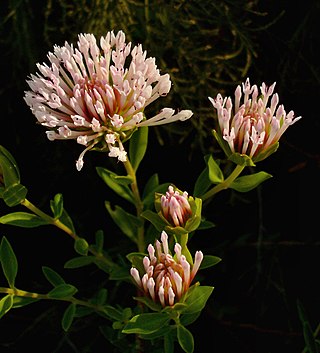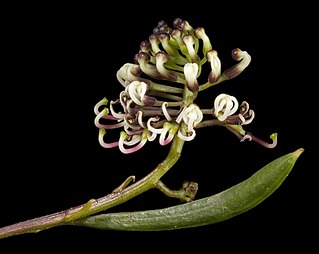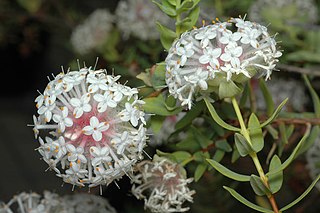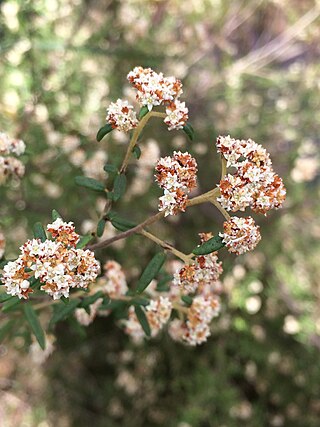
Pimelea calcicola is a species of flowering plant in the family Thymelaeaceae and is endemic to part of the west coast of Western Australia. It is an erect to spreading shrub with elliptic leaves arranged in opposite pairs, and head-like racemes of pale to deep pink, tube-shaped flowers surrounded by leaf-like involucral bracts.

Grevillea diversifolia, the variable-leaved grevillea, is a species of flowering plant in the family Proteaceae and is endemic to the south-west of Western Australia. It is an erect to prostrate shrub with simple or divided leaves and groups white to cream-coloured flowers with a dull red style.

Pimelea ferruginea, commonly known as pink rice flower or coastal banjine, is a species of flowering plant in the family Thymelaeaceae and is endemic to near-coastal areas of south-western Western Australia. It is a dense, erect shrub with elliptic to narrowly elliptic leaves and head-like clusters of pale to deep pink, tube-shaped flowers.

Grevillea hirtella is a species of flowering plant in the family Proteaceae and is endemic to the west of Western Australia. It is a spreading shrub with crowded linear and divided leaves and clusters of pale pink to deep red flowers.

Grevillea hislopii is a species of flowering plant in the family Proteaceae and is endemic to a restricted area of the south-west of Western Australia. It is a dense, single-stemmed shrub with linear to narrow elliptic leaves and clusters of hairy, whitish-grey flowers.

Grevillea papillosa is a species of flowering plant in the family Proteaceae and is endemic to the South West region of Western Australia. It is a spreading shrub with narrowly elliptic to linear, as well as deeply divided leaves, and pink-tinged, white flowers with a reddish-pink style.

Pimelea ammocharis is a species of small shrub in the family Thymelaeaceae. It is a small shrub with white-yellow to orange flowers and is endemic to Western Australia.

Pimelea ciliata, commonly known as white banjine, is a species of flowering plant in the family Thymelaeaceae. It is a small shrub with white flowers and is endemic to Western Australia.
Daviesia newbeyi is a species of flowering plant in the family Fabaceae and is endemic to the south-west of Western Australia. It is a bushy, broom-like, more or less glabrous shrub with ridged stems, narrowly oblong to linear phyllodes, and orange flowers with dark red markings.

Daviesia preissii is a species of flowering plant in the family Fabaceae and is endemic to the south-west of Western Australia. It is a glabrous shrub with scattered, vertically flattened, tapering, narrowly egg-shaped to elliptic, sharply-pointed phyllodes and yellow and red flowers.

Pimelea argentea, commonly known as silvery leaved pimelea, is a species of flowering plant in the family Thymelaeaceae and is endemic to the south-west of Western Australia. It is an erect shrub with densely hairy young stems and leaves, the leaves linear to elliptic, and heads of white to yellow or greenish flowers, the male and female flowers on separate plants.

Pimelea avonensis is a species of flowering plant in the family Thymelaeaceae and is endemic to the south-west of Western Australia. It is a shrub with narrowly egg-shaped or elliptic leaves and clusters of white, tube-shaped flowers.
Pimelea clavata is a species of flowering plant in the family Thymelaeaceae and is endemic to near-coastal areas and offshore islands of southern Western Australia. It is an erect shrub with narrowly elliptic to more or less linear leaves arranged in opposite pairs, and head-like clusters of white to pale yellow, tube-shaped flowers surrounded by leaf-like involucral bracts.

Pimelea cracens is a species of flowering plant in the family Thymelaeaceae and is endemic to the southwest of Western Australia. It is an erect, spindly shrub with narrowly elliptic to egg-shaped leaves and creamy green to pale yellow flowers surrounded by 6 or 8 yellowish or pale green and reddish involucral bracts.
Pimelea drummondii is a species of flowering plant in the family Thymelaeaceae and is endemic to near-coastal areas of southern Western Australia. It is an erect, slender shrub with narrowly elliptic or elliptic leaves arranged in opposite pairs, and white or cream-coloured flowers surrounded by 3 or 4 pairs of pale green to yellowish involucral bracts.

Spyridium riparium is a species of flowering plant in the family Rhamnaceae and is endemic to the south of Western Australia. It is an erect shrub, usually with narrowly egg-shaped leaves, and clusters of densely hairy, white or cream-coloured flowers.
Pimelea erecta is a species of flowering plant in the family Thymelaeaceae and is endemic to the southwest of Western Australia. It is an erect, often spreading shrub with elliptic to egg-shaped leaves arranged in opposite pairs, and clusters of erect, white or pale pink flowers.
Pimelea eyrei is a species of flowering plant in the family Thymelaeaceae and is endemic to the southwest of Western Australia. It is an erect shrub with hairy, narrowly elliptic leaves and clusters of densely hairy, white or cream-coloured flowers.

Pimelea floribunda is a species of flowering plant in the family Thymelaeaceae and is endemic to the south-west of Western Australia. It is a shrub with narrowly elliptic to egg-shaped leaves arranged in opposite pairs, and drooping, head-like clusters of white or cream-coloured, tube-shaped flowers.
Pimelea gilgiana is a species of flowering plant in the family Thymelaeaceae and is endemic to near-coastal areas of north-western Western Australia. It is a shrub with narrowly egg-shaped leaves and head-like clusters of white or pinkish, dioecious flowers.













